Using a Vegetation Index to Monitor the Death Process of Chinese Fir Based on Hyperspectral Data
Abstract
:1. Introduction
2. Materials and Methods
2.1. Study Area
2.2. Experimental Design and Data Collection
2.3. Reflectance Extraction of Sample Points
2.4. Vegetation Indices Calculation
2.5. Statistical Analysis
3. Results
3.1. Comparison of Monthly Average Spectral Curves
3.2. Comparison of Monitoring Effectiveness of Vegetation Indices
3.3. Effectiveness Evaluation of REP and GRRSGI
3.4. Validation of the Sensitivity of the Collection of Bands (550 nm–640 nm) Used by GRRSGI
4. Discussion
5. Conclusions
Author Contributions
Funding
Data Availability Statement
Conflicts of Interest
References
- Lei, L.; Chai, G.; Wang, Y.; Jia, X.; Yin, T.; Zhang, X. Estimating Individual Tree Above-Ground Biomass of Chinese Fir Plantation: Exploring the Combination of Multi-Dimensional Features from UAV Oblique Photos. Remote Sens. 2022, 14, 504. [Google Scholar] [CrossRef]
- You, R.; Zhu, N.; Deng, X.; Wang, J.; Liu, F. Variation in Wood Physical Properties and Effects of Climate for Different Geographic Sources of Chinese Fir in Subtropical Area of China. Sci. Rep. 2021, 11, 4664. [Google Scholar] [CrossRef] [PubMed]
- Yin, T.; Zeng, J.; Zhang, X.; Zhou, X. Individual Tree Parameters Estimation for Chinese Fir (Cunninghamia lanceolate (Lamb.) Hook) Plantations of South China Using UAV Oblique Photography: Possibilities and Challenges. IEEE J. Sel. Top. Appl. Earth Obs. Remote Sens. 2021, 14, 827–842. [Google Scholar] [CrossRef]
- Lei, J.; Wu, H.; Li, X.; Guo, W.; Duan, A.; Zhang, J. Response of Rhizosphere Bacterial Communities to Near-Natural Forest Management and Tree Species within Chinese Fir Plantations. Microbiol. Spectr. 2023, 11, e02328-22. [Google Scholar] [CrossRef] [PubMed]
- Zhang, N.; Yang, G.; Pan, Y.; Yang, X.; Chen, L.; Zhao, C. A Review of Advanced Technologies and Development for Hyperspectral-Based Plant Disease Detection in the Past Three Decades. Remote Sens. 2020, 12, 3188. [Google Scholar] [CrossRef]
- Long, L.; Chen, Y.; Song, S.; Zhang, X.; Jia, X.; Lu, Y.; Liu, G. Remote Sensing Monitoring of Pine Wilt Disease Based on Time-Series Remote Sensing Index. Remote Sens. 2023, 15, 360. [Google Scholar] [CrossRef]
- Gooshbor, L.; Bavaghar, M.P.; Amanollahi, J.; Ghobari, H. Monitoring infestations of oak forests by Tortrix viridana (Lepidoptera: Tortricidae) using remote sensing. Plant Prot. Sci. 2016, 52, 270–276. [Google Scholar] [CrossRef]
- Duarte, A.; Acevedo-Muñoz, L.; Gonçalves, C.I.; Mota, L.; Sarmento, A.; Silva, M.; Fabres, S.; Borralho, N.; Valente, C. Detection of Longhorned Borer Attack and Assessment in Eucalyptus Plantations Using UAV Imagery. Remote Sens. 2020, 12, 3153. [Google Scholar] [CrossRef]
- Xiao, D.; Pan, Y.; Feng, J.; Yin, J.; Liu, Y.; He, L. Remote Sensing Detection Algorithm for Apple Fire Blight Based on UAV Multispectral Image. Comput. Electron. Agric. 2022, 199, 107137. [Google Scholar] [CrossRef]
- Chang, A.; Yeom, J.; Jung, J.; Landivar, J. Comparison of Canopy Shape and Vegetation Indices of Citrus Trees Derived from UAV Multispectral Images for Characterization of Citrus Greening Disease. Remote Sens. 2020, 12, 4122. [Google Scholar] [CrossRef]
- Han, L.; Yang, G.; Dai, H.; Xu, B.; Yang, H.; Feng, H.; Li, Z.; Yang, X. Modeling Maize Above-Ground Biomass Based on Machine Learning Approaches Using UAV Remote-Sensing Data. Plant Methods 2019, 15, 10. [Google Scholar] [CrossRef] [PubMed]
- Gold, K.M.; Townsend, P.A.; Chlus, A.; Herrmann, I.; Couture, J.J.; Larson, E.R.; Gevens, A.J. Hyperspectral Measurements Enable Pre-Symptomatic Detection and Differentiation of Contrasting Physiological Effects of Late Blight and Early Blight in Potato. Remote Sens. 2020, 12, 286. [Google Scholar] [CrossRef]
- Xi, G.; Huang, X.; Xie, Y.; Gang, B.; Bao, Y.; Dashzebeg, G.; Nanzad, T.; Dorjsuren, A.; Enkhnasan, D.; Ariunaa, M. Detection of Larch Forest Stress from Jas’s Larch Inchworm (Erannis Jacobsoni Djak) Attack Using Hyperspectral Remote Sensing. Remote Sens. 2022, 14, 124. [Google Scholar] [CrossRef]
- Donovan, S.D.; MacLean, D.A.; Zhang, Y.; Lavigne, M.B.; Kershaw, J.A. Evaluating Annual Spruce Budworm Defoliation Using Change Detection of Vegetation Indices Calculated from Satellite Hyperspectral Imagery. Remote Sens. Environ. 2021, 253, 112204. [Google Scholar] [CrossRef]
- Pan, J.; Lin, J.; Xie, T. Exploring the Potential of UAV-Based Hyperspectral Imagery on Pine Wilt Disease Detection: Influence of Spatio-Temporal Scales. Remote Sens. 2023, 15, 2281. [Google Scholar] [CrossRef]
- Yu, R.; Ren, L.; Luo, Y. Early Detection of Pine Wilt Disease in Pinus Tabuliformis in North China Using a Field Portable Spectrometer and UAV-Based Hyperspectral Imagery. For. Ecosyst. 2021, 8, 44. [Google Scholar] [CrossRef]
- Jiang, X.; Zhen, J.; Miao, J.; Zhao, D.; Wang, J.; Jia, S. Assessing Mangrove Leaf Traits under Different Pest and Disease Severity with Hyperspectral Imaging Spectroscopy. Ecol. Indic. 2021, 129, 107901. [Google Scholar] [CrossRef]
- Jiang, X.; Zhen, J.; Miao, J.; Zhao, D.; Shen, Z.; Jiang, J.; Gao, C.; Wu, G.; Wang, J. Newly-Developed Three-Band Hyperspectral Vegetation Index for Estimating Leaf Relative Chlorophyll Content of Mangrove under Different Severities of Pest and Disease. Ecol. Indic. 2022, 140, 108978. [Google Scholar] [CrossRef]
- Kim, S.-R.; Lee, W.-K.; Lim, C.-H.; Kim, M.; Kafatos, M.C.; Lee, S.-H.; Lee, S.-S. Hyperspectral Analysis of Pine Wilt Disease to Determine an Optimal Detection Index. Forests 2018, 9, 115. [Google Scholar] [CrossRef]
- Zang, Z.; Wang, G.; Lin, H.; Luo, P. Developing a Spectral Angle Based Vegetation Index for Detecting the Early Dying Process of Chinese Fir Trees. ISPRS J. Photogramm. Remote Sens. 2021, 171, 253–265. [Google Scholar] [CrossRef]
- Zhang, T.; Lin, H.; Long, J.; Zheng, H.; Ye, Z.; Liu, Z. Evaluating the Sensitivity of Polarimetric Features Related to Rotation Domain and Mapping Chinese Fir AGB Using Quad-Polarimetric SAR Images. Remote Sens. 2023, 15, 1519. [Google Scholar] [CrossRef]
- Xue, J.; Su, B. Significant Remote Sensing Vegetation Indices: A Review of Developments and Applications. J. Sens. 2017, 2017, e1353691. [Google Scholar] [CrossRef]
- Rouse, J.W.; Haas, R.H.; Schell, J.A.; Deering, D.W. Monitoring Vegetation Systems in the Great Plains with ERTS; NASA: Washington, DC, USA, 1974. [Google Scholar]
- Gitelson, A.A.; Kaufman, Y.J.; Stark, R.; Rundquist, D. Novel Algorithms for Remote Estimation of Vegetation Fraction. Remote Sens. Environ. 2002, 80, 76–87. [Google Scholar] [CrossRef]
- Penuelas, J.; Filella, I.; Lloret, P.; Munoz, F.; Vilajeliu, M. Reflectance Assessment of Mite Effects on Apple Trees. Int. J. Remote Sens. 1995, 16, 2727–2733. [Google Scholar] [CrossRef]
- Gitelson, A.A.; Merzlyak, M.N.; Lichtenthaler, H.K. Detection of Red Edge Position and Chlorophyll Content by Reflectance Measurements Near 700 Nm. J. Plant Physiol. 1996, 148, 501–508. [Google Scholar] [CrossRef]
- Merzlyak, M.N.; Gitelson, A.A.; Chivkunova, O.B.; Rakitin, V.Y. Non-Destructive Optical Detection of Pigment Changes during Leaf Senescence and Fruit Ripening. Physiol. Plant. 1999, 106, 135–141. [Google Scholar] [CrossRef]
- Chappelle, E.W.; Kim, M.S.; McMurtrey, J.E. Ratio Analysis of Reflectance Spectra (RARS): An Algorithm for the Remote Estimation of the Concentrations of Chlorophyll A, Chlorophyll B, and Carotenoids in Soybean Leaves. Remote Sens. Environ. 1992, 39, 239–247. [Google Scholar] [CrossRef]
- Guyot, G.; Baret, F. Utilisation de la Haute Résolution Spectrale pour Suivre L’état des Couverts Végétaux. In Proceedings of the 4th International Colloquium on Spectral Signatures of Objects in Remote Sensing, Aussois, France, 18–22 January 1988; pp. 279–286. [Google Scholar]
- Uto, K.; Takabayashi, Y.; Kosugi, Y.; Ogata, T. Hyperspectral Analysis of Japanese Oak Wilt to Determine Normalized Wilt Index. In Proceedings of the IGARSS 2008—2008 IEEE International Geoscience and Remote Sensing Symposium, Boston, MA, USA, 7–11 July 2008; Volume 2, pp. II-295–II-298. [Google Scholar]
- Spruce, J.P.; Hicke, J.A.; Hargrove, W.W.; Grulke, N.E.; Meddens, A.J.H. Use of MODIS NDVI Products to Map Tree Mortality Levels in Forests Affected by Mountain Pine Beetle Outbreaks. Forests 2019, 10, 811. [Google Scholar] [CrossRef]
- Olsson, P.-O.; Lindström, J.; Eklundh, L. Near Real-Time Monitoring of Insect Induced Defoliation in Subalpine Birch Forests with MODIS Derived NDVI. Remote Sens. Environ. 2016, 181, 42–53. [Google Scholar] [CrossRef]
- Liu, M.; Zhang, Z.; Liu, X.; Li, M.; Shi, L. Trend Analysis of Coverage Variation in Pinus Yunnanensis Franch. Forests under the Influence of Pests and Abiotic Factors. Forests 2022, 13, 412. [Google Scholar] [CrossRef]
- Georgieva, M.; Belilov, S.; Dimitrov, S.; Iliev, M.; Trenkin, V.; Mirchev, P.; Georgiev, G. Application of Remote Sensing Data for Assessment of Bark Beetle Attacks in Pine Plantations in Kirkovo Region, the Eastern Rhodopes. Forests 2022, 13, 620. [Google Scholar] [CrossRef]
- Varpe, A.B.; Surase, R.R.; Vibhute, A.D.; Gaikwad, S.V.; Rajendra, Y.D.; Kale, K.V.; Mehrotra, S.C. Synygium Cumini Plant Photosynthetic Pigment Detection from Hyperspectral Datasets Using Spectral Indices. In Proceedings of the 2017 2nd International Conference on Man and Machine Interfacing (MAMI), Bhubaneswar, India, 21–23 December 2017; IEEE: Bhubaneswar, India, 2017; pp. 1–6. [Google Scholar]
- Blackburn, G.A. Spectral Indices for Estimating Photosynthetic Pigment Concentrations: A Test Using Senescent Tree Leaves. Int. J. Remote Sens. 1998, 19, 657–675. [Google Scholar] [CrossRef]
- Yu, R.; Huo, L.; Huang, H.; Yuan, Y.; Gao, B.; Liu, Y.; Yu, L.; Li, H.; Yang, L.; Ren, L.; et al. Early Detection of Pine Wilt Disease Tree Candidates Using Time-Series of Spectral Signatures. Front. Plant Sci. 2022, 13, 1000093. [Google Scholar] [CrossRef] [PubMed]
- Wu, D.; Yu, L.; Yu, R.; Zhou, Q.; Li, J.; Zhang, X.; Ren, L.; Luo, Y. Detection of the Monitoring Window for Pine Wilt Disease Using Multi-Temporal UAV-Based Multispectral Imagery and Machine Learning Algorithms. Remote Sens. 2023, 15, 444. [Google Scholar] [CrossRef]
- Feifei, Y.; Shengping, L.I.U.; Yeping, Z.H.U.; Shijuan, L.I. Identification and Level Discrimination of Waterlogging Stress in Winter Wheat Using Hyperspectral Remote Sensing. Smart Agric. 2021, 3, 35. [Google Scholar] [CrossRef]
- Baath, G.S.; Flynn, K.C.; Gowda, P.H.; Kakani, V.G.; Northup, B.K. Detecting Biophysical Characteristics and Nitrogen Status of Finger Millet at Hyperspectral and Multispectral Resolutions. Front. Agron. 2021, 2, 604598. [Google Scholar] [CrossRef]
- Schneider, P.; Roberts, D.A.; Kyriakidis, P.C. A VARI-Based Relative Greenness from MODIS Data for Computing the Fire Potential Index. Remote Sens. Environ. 2008, 112, 1151–1167. [Google Scholar] [CrossRef]
- Anisa, M.; Rokhmatuloh, R.; Hernina, R. UAV Application to Estimate Oil Palm Trees Health Using Visible Atmospherically Resistant Index (VARI) (Case Study of Cikabayan Research Farm, Bogor City). E3S Web Conf. 2020, 211, 05001. [Google Scholar] [CrossRef]
- Hoshikawa, T.; Yamamoto, K. Individual Tree Detection and Classification for Mapping Pine Wilt Disease Using Multispectral and Visible Color Imagery Acquired from Unmanned Aerial Vehicle. J. Remote Sens. Soc. Jpn. 2020, 40, 13–19. [Google Scholar] [CrossRef]
- De Castro, A.I.; Ehsani, R.; Ploetz, R.; Crane, J.H.; Abdulridha, J. Optimum Spectral and Geometric Parameters for Early Detection of Laurel Wilt Disease in Avocado. Remote Sens. Environ. 2015, 171, 33–44. [Google Scholar] [CrossRef]
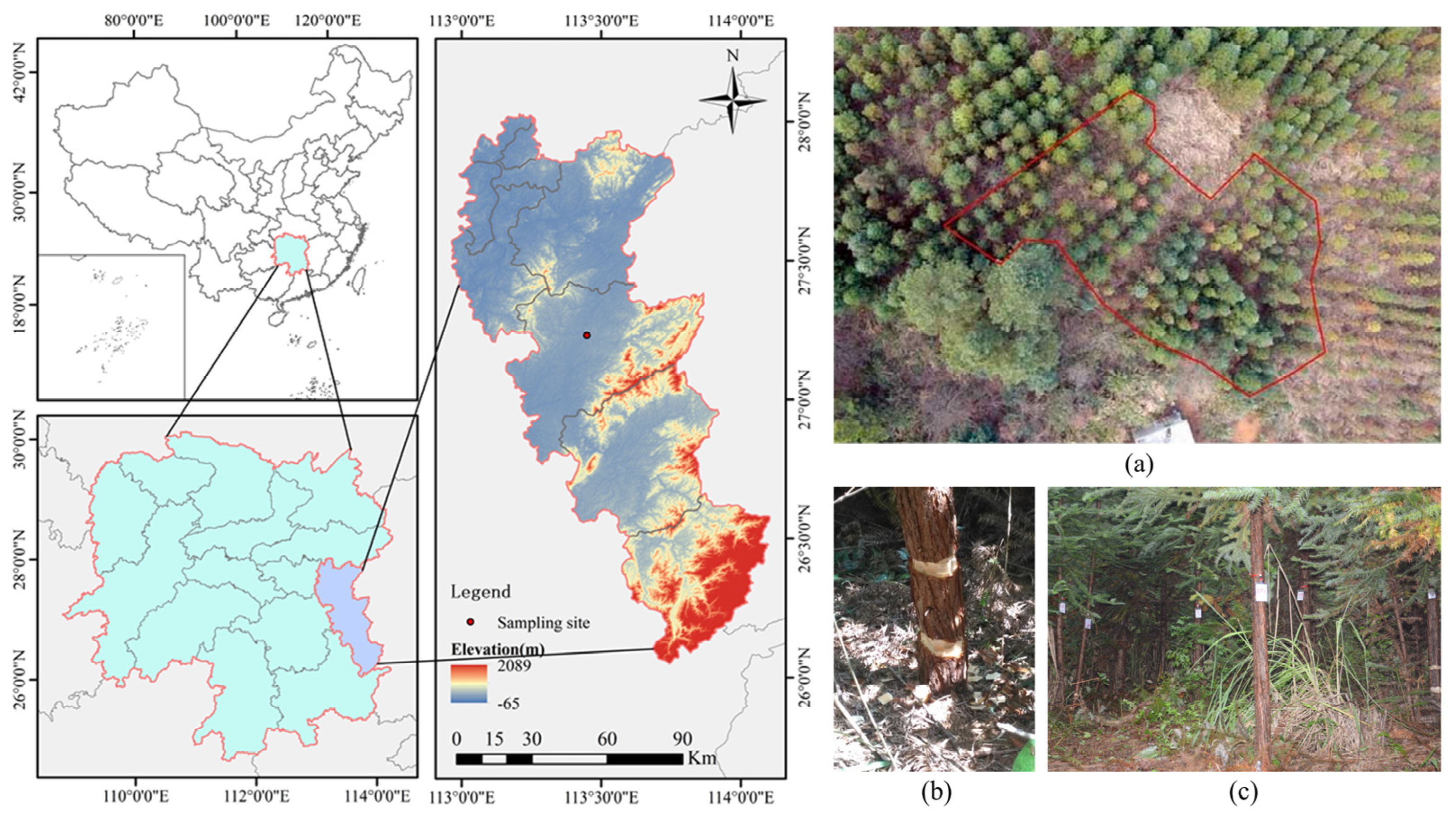
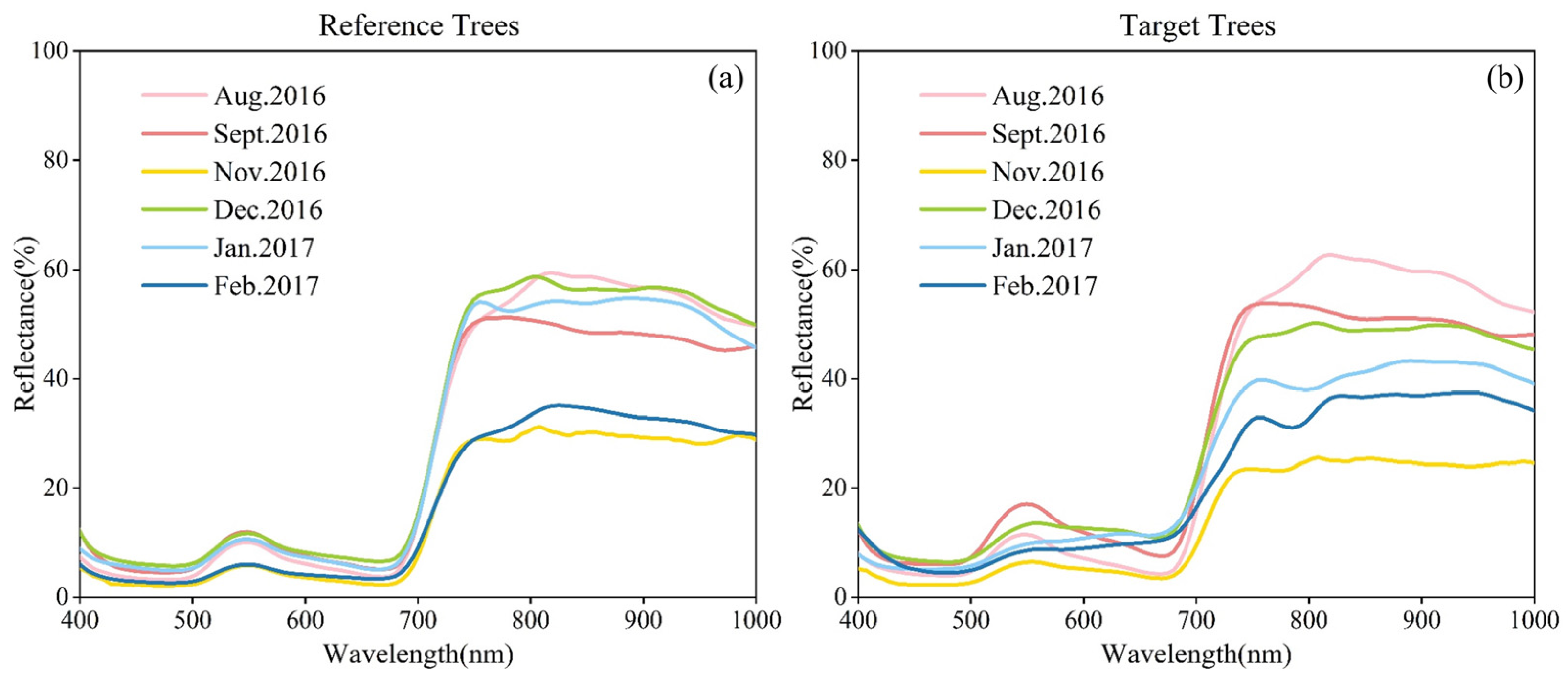
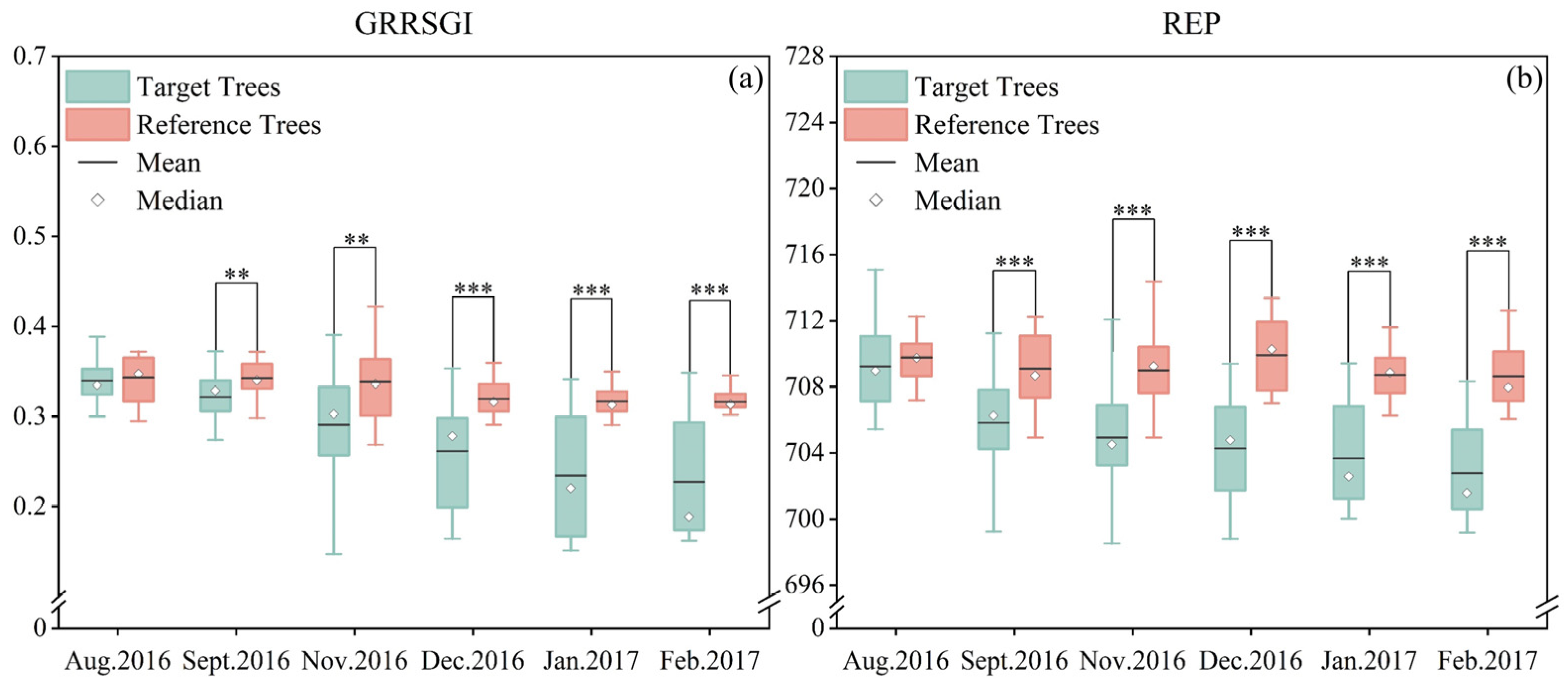
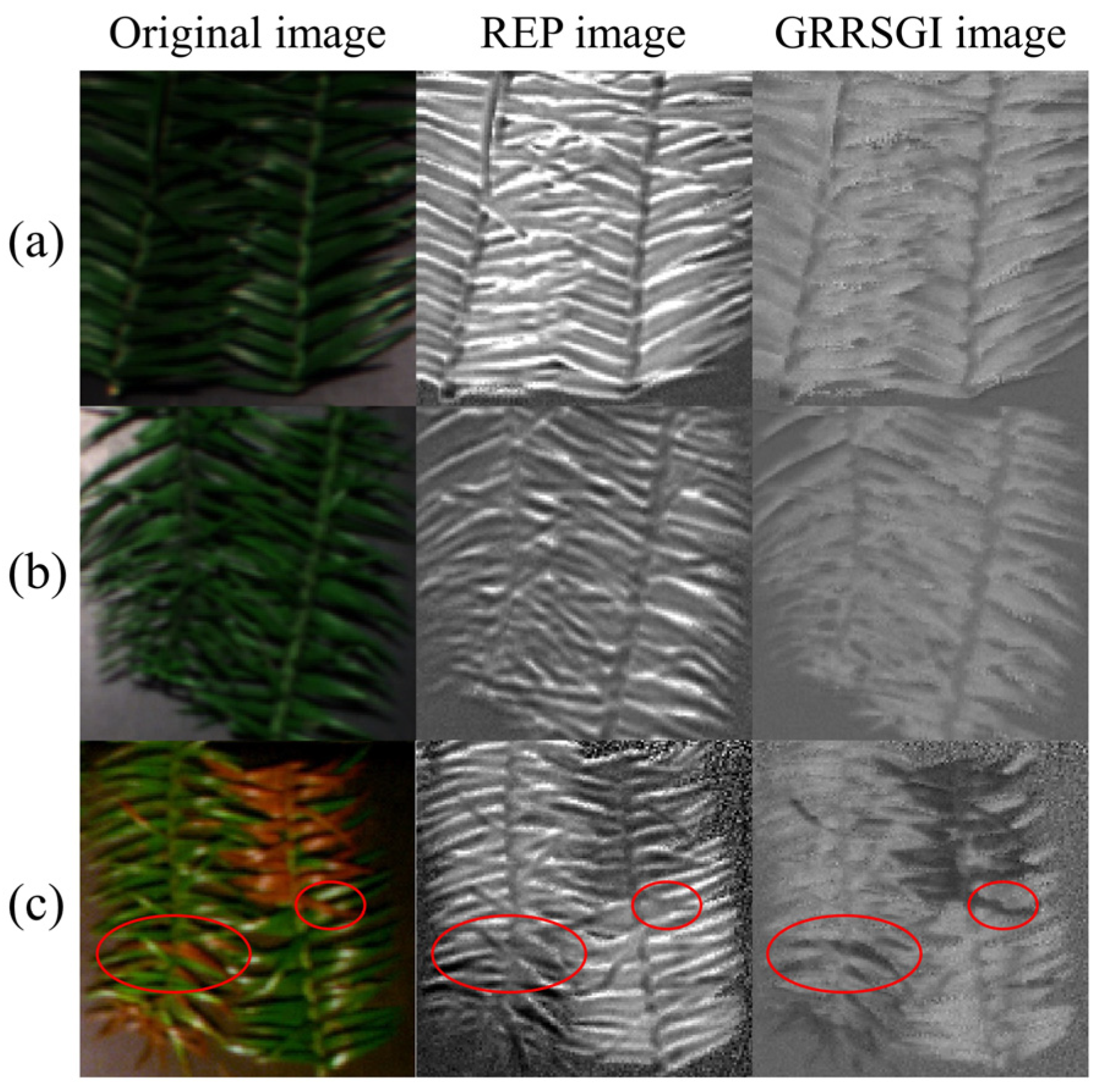
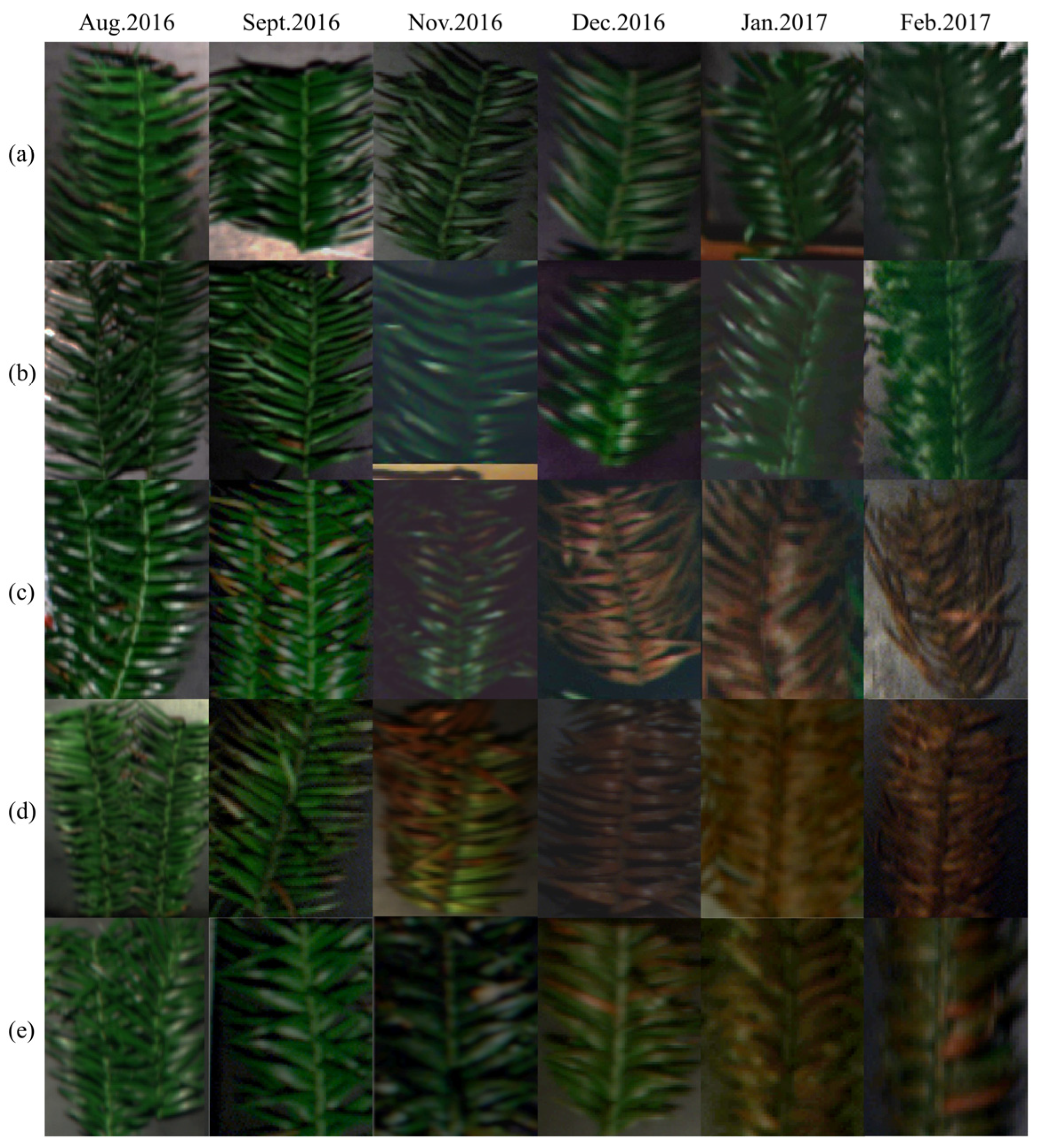

| Vegetation Index | Equation | Reference |
|---|---|---|
| Normalized difference vegetation index (NDVI) | Rouse et al. [23] | |
| Green normalized difference vegetation index (GNDVI) | Gitelson et al. [24] | |
| Simple ratio pigment index (SRPI) | Penuelas et al. [25] | |
| Vegetation index green (VIgreen) | Gitelson et al. [26] | |
| Plant senescing reflectance index (PSRI) | Merzlyak et al. [27] | |
| Vegetation atmospherically resistant index (VARI) | Gitelson et al. [26] | |
| Pigment-specific normalized difference (PSND) | Chappelle et al. [28] | |
| Red edge position (REP) | Guyot & Baret [29] | |
| Normalized with index (NWI) | Uto et al. [30] | |
| Green–red spectral area index (GRSAI) | Kim et al. [19] | |
| Green-to-red region spectral angle index (GRRSGI) 1 | Zhuo Zang et al. [20] |
| VIs | August 2016 | September 2016 | November 2016 | December 2016 | January 2017 | February 2017 | ||||||
|---|---|---|---|---|---|---|---|---|---|---|---|---|
| p | Median Difference (95%CI) | p | Median Difference (95%CI) | p | Median Difference (95%CI) | p | Median Difference (95%CI) | p | Median Difference (95%CI) | p | Median Difference (95%CI) | |
| NDVI | 0.395 | −0.02(−0.05, 0.01) | 0.000 *** | −0.05(−0.10, −0.02) | 0.037 * | −0.03(−0.10, −0.02) | 0.008 ** | −0.07(−0.11, 0.00) | 0.004 ** | −0.11(−0.41, −0.04) | 0.000 *** | −0.46(−0.50, −0.05) |
| GNDVI | 0.361 | −0.02(−0.06, 0.02) | 0.000 *** | −0.10(−0.16, −0.04) | 0.003 ** | −0.06(−0.15, −0.01) | 0.000 *** | −0.11(−0.15, −0.03) | 0.059 | −0.03(−0.09, 0.00) | 0.000 *** | −0.08(−0.11, −0.03) |
| SRPI | 0.536 | 0.09(−0.13, 0.22) | 0.000 *** | −0.30(−0.37, −0.12) | 0.667 | 0.28(−0.54, 0.67) | 0.003 ** | −0.15(−0.30, −0.03) | 0.003 ** | −0.23(−0.85, −0.03) | 0.011 * | −0.43(−0.68, −0.08) |
| VIgreen | 0.564 | 0.02(−0.11, 0.11) | 0.289 | 0.03(−0.04, 0.10) | 0.713 | −0.02(−0.14, 0.14) | 0.564 | 0.03(−0.07, 0.13) | 0.124 | 0.10(−0.04, 0.70) | 0.007 ** | 0.57(0.03, 0.67) |
| PSRI | 0.958 | 0.00(−0.01, 0.01) | 0.087 | 0.01(0.00, 0.03) | 0.133 | 0.01(−0.01, 0.04) | 0.15 | 0.01(−0.01, 0.04) | 0.165 | 0.02(−0.01, 0.35) | 0.004 ** | 0.28(0.01, 0.40) |
| VARI | 0.745 | −0.02(−0.11, 0.12) | 0.189 | −0.01(−0.13, 0.03) | 0.372 | −0.02(−0.22, 0.15) | 0.383 | −0.04(−0.17, 0.05) | 0.082 | −0.17(−0.94, 0.03) | 0.024 * | −0.86(−0.93, −0.09) |
| PSND | 0.35 | −0.02(−0.05, 0.02) | 0.000 *** | −0.06(−0.09, −0.02) | 0.005 ** | −0.05(−0.12, 0.00) | 0.011 * | −0.06(−0.10, −0.01) | 0.003 ** | −0.10(−0.50, −0.04) | 0.000 *** | −0.52(−0.58, −0.09) |
| REP | 0.35 | −0.77(−2.23, 0.98) | 0.000 *** | −2.41(−5.58, −0.95) | 0.000 *** | −3.69(−5.61, −2.23) | 0.000 *** | −5.49(−8.49, −2.44) | 0.000 *** | −6.27(−7.68, −3.01) | 0.000 *** | −6.38(−8.60, −3.80) |
| NWI | 0.825 | 0.00(−0.01, 0.02) | 0.000 *** | −0.02(−0.04, −0.01) | 0.002 ** | −0.03(−0.05, −0.01) | 0.027 * | −0.02(−0.05, −0.01) | 0.002 ** | −0.05(−0.36, −0.01) | 0.001 ** | −0.29(−0.36, −0.03 ) |
| GRSAI | 0.508 | 0.01(−0.01, 0.02) | 0.014 * | 0.01(0.00, 0.02) | 0.000 *** | 0.01(0.00, 0.03) | 0.000 *** | 0.02(0.01, 0.05) | 0.000 *** | 0.07(0.02, 0.13) | 0.000 *** | 0.10(0.02, 0.12) |
| GRRSGI | 0.443 | −0.01(−0.03, 0.01) | 0.009 ** | −0.01(−0.03, 0.00) | 0.006 ** | −0.02(−0.08, 0.00) | 0.000 *** | −0.04(−0.07, −0.02) | 0.000 *** | −0.09(−0.15, −0.03) | 0.000 *** | −0.13(−0.14, −0.04) |
Disclaimer/Publisher’s Note: The statements, opinions and data contained in all publications are solely those of the individual author(s) and contributor(s) and not of MDPI and/or the editor(s). MDPI and/or the editor(s) disclaim responsibility for any injury to people or property resulting from any ideas, methods, instructions or products referred to in the content. |
© 2023 by the authors. Licensee MDPI, Basel, Switzerland. This article is an open access article distributed under the terms and conditions of the Creative Commons Attribution (CC BY) license (https://creativecommons.org/licenses/by/4.0/).
Share and Cite
Tang, X.; Zang, Z.; Lin, H.; Wang, X.; Wen, Z. Using a Vegetation Index to Monitor the Death Process of Chinese Fir Based on Hyperspectral Data. Forests 2023, 14, 2444. https://doi.org/10.3390/f14122444
Tang X, Zang Z, Lin H, Wang X, Wen Z. Using a Vegetation Index to Monitor the Death Process of Chinese Fir Based on Hyperspectral Data. Forests. 2023; 14(12):2444. https://doi.org/10.3390/f14122444
Chicago/Turabian StyleTang, Xuemei, Zhuo Zang, Hui Lin, Xu Wang, and Zhang Wen. 2023. "Using a Vegetation Index to Monitor the Death Process of Chinese Fir Based on Hyperspectral Data" Forests 14, no. 12: 2444. https://doi.org/10.3390/f14122444
APA StyleTang, X., Zang, Z., Lin, H., Wang, X., & Wen, Z. (2023). Using a Vegetation Index to Monitor the Death Process of Chinese Fir Based on Hyperspectral Data. Forests, 14(12), 2444. https://doi.org/10.3390/f14122444







